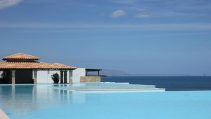Underwater pool lighting is one of the most important ways to bring even more appeal to your pool area. You’ve spent much time, energy and money on this investment, and fantastic lighting can be the “final touch” that your pool needs. Choosing a lighting setup can be more complicated than it looks, but with a little knowledge, it will be easier to navigate the many choices that need to be made.

It’s important to have a handle on code requirements, lighting terminology and trends within the pool industry. Well-chosen pool lighting improves the overall aesthetic, and also sets the mood through a variety of colors and effects to choose from for your pool. Let’s take a look at some of the most important things to remember while going through the process of lighting selection.
Whether you are a DIY enthusiast or you are going to get help from a local professional swimming pool contractor or a licensed electrician to do the installation job, this article will educate you on the basics so you will choose and install the best swimming pool lighting for your needs.
#1 What Are the Main Types of Pool Lights?
- LEDs: This is by far the most common type of pool light. LED stands for Light Emitting Diodes. LED lighting is so appealing because you can change the colors with a push of a button. With the average LED light lasting 30,000 hours, they have a really long life span compared to other type of lights.
- Fiber optics: These lights are not as popular as they once were due to the fact that LED lights have become more common. Many fiber optic lights have the ability to rotate colors. The average lifespan of a fiber optic light is approximately 6,000 hours.
- Incandescent: This type of pool light is the least common due to the fact that in order to change colors it is necessary to physically change the cover on the pool light to experience different colors in the pool. These were common over twenty years ago, but they now seem rather dated. Of the three types, they have the shortest life span with approximately 5,000 hours of light emitted.
#2 What About the Price?
It’s important to know that underwater lighting can be quite expensive. In general, LED lights are the most economical, but here are some estimates.
- LED lights cost about$1,000-$1,500 to install.
- Fiber optic lights are usually $1,300-$1,700.
- Incandescent lights typically run $450-$650.
#3 Which Brand Is the Best?
There are many well-established brands on the market. The name brand lights will cost somewhere between $380 and $700. In general, the name brand lights are good quality; however, expect to pay at least twice the price for a non-generic lights.
Generic brands can be high quality as well, but it’s advisable to do more research on generic brands. Many companies will stand by their product if customers are not completely satisfied, so it’s important to find a company who will do this. It’s a good idea to spend the time reading user reviews online if you decide to go the generic route.
#4 How Do I Use Lighting Around My Pool?
- Low-voltage lighting around your pool will create a soft glow that will create pleasant ambience, so you will want to spend time by the pool at night. There are a variety of options to consider for lighting around the pool. Not only will it be pleasing to look at, but it will make you feel safer.
- Consider using well-placed light to illuminate walkways to get to the pool at night. With this type of lighting in place, it is less likely that you or your guests will trip over plants or pool toys or anything else.
- Also consider lighting pergolas, patios and decks. It will greatly enhance the look of your pool area and increase the likelihood of spending more time outside at night.
- Remember that outdoor lighting kits are easy to install and can be done over a period of time.
#5 Do I need to Install Underwater Pool Lights During Construction?
It may be tempting to try and put off installation of underwater pool lighting later in the process. After all, it’s an expensive endeavor and maybe you’re thinking that it’s possible to spread out expenses. It can be done, but it is far more complicated process in the long run, and it is not advisable.
It’s less difficult to do at the time of construction because the majority of lights need to have a hole in the wall of the pool. If you decide to try and install pool lighting later, it’s more complicated because it will be necessary to go under the deck, cut a hole in the pool wall, and then run a conduit to the junction box.
#6 What About Solar Lighting?
Solar lighting is a great option to help fill in the gaps of areas where soft lighting is needed around the pool. Solar products come in a wide range of quality, and it’s probably not possible to do all of your pool lighting with solar lighting.
However, it’s a great option for filling in some gaps in your outdoor lighting needs. A fun touch is using solar balls to float in the pool at night. They are inexpensive ($40-$80) and come in a wide variety of colors.
#7 How Does the Lighting Look from the House?
It’s important to remember what the effect of the lighting will be from inside your house. The last thing anyone wants is to have lights that don’t look good from inside the house or that will produce too much light while indoors. Does your lighting enhance the patio and landscaping?
Your lighting choices may look great from the outside, but totally flop in how it looks from inside. Consider all these aspects before spending money on pool lighting. You’ll be glad that you remembered to think about this.
Pool lighting is one of the most fun aspects of designing the pool of your dreams. It’s a chance to really show off your personality and create a space that is inviting. We hope these tips were helpful, and that you are well on your way to achieving your dream backyard space.
Assigned category: Swimming Pools


